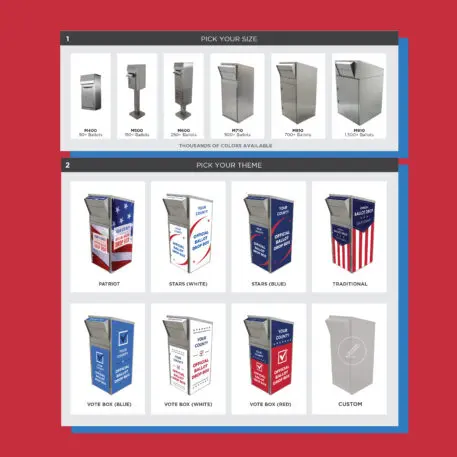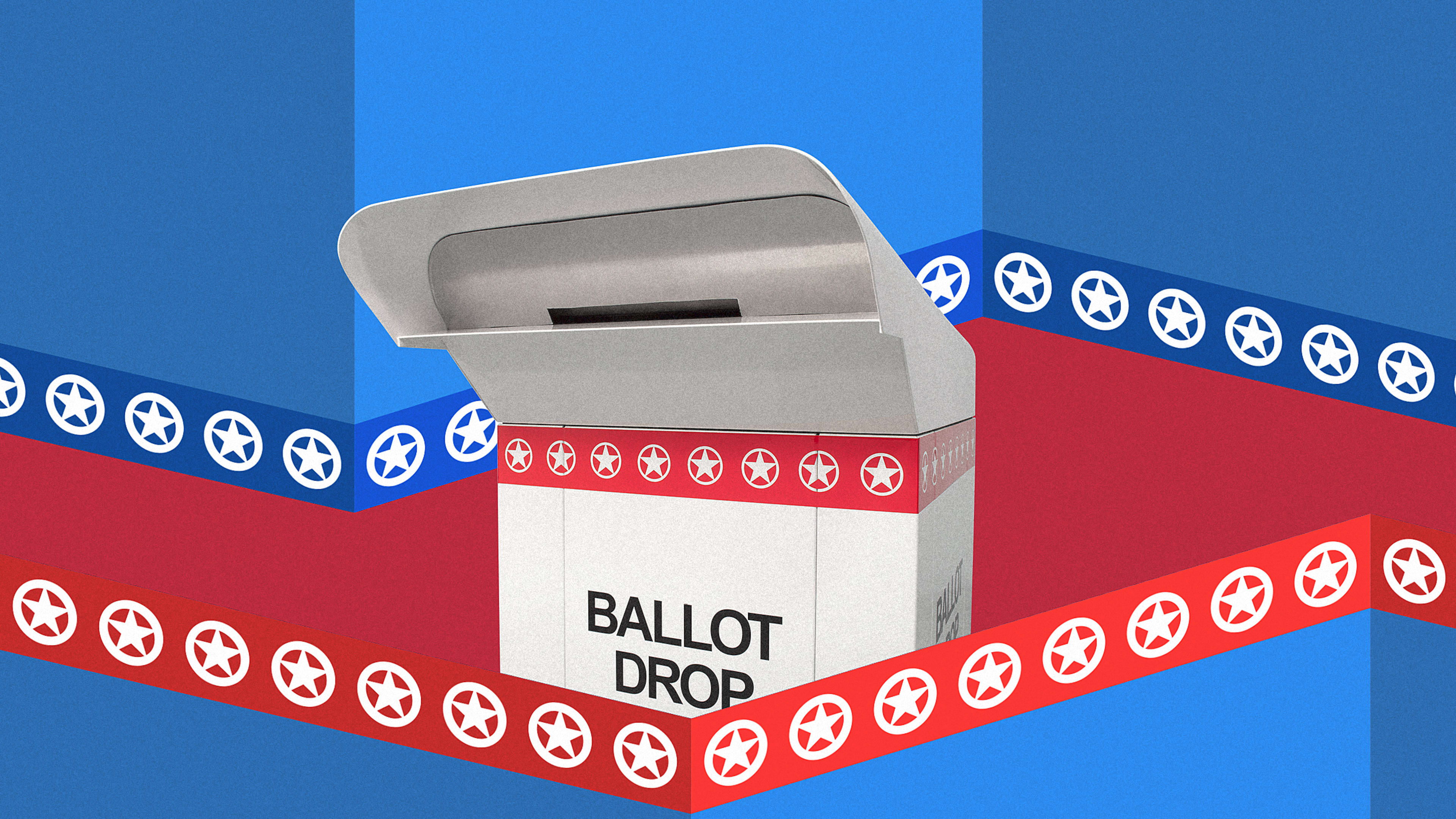Last week, Murray Morgan received a call from representatives of the state of Texas.
Morgan is the CEO of Kingsley, the world’s leading manufacturer of secure library drop-off boxes. The company also produces similar boxes for drop-off voting. As COVID-19 potentially wreaks havoc on in-person polls, and as the USPS is facing potential sabatoge to manage a surge in mail-in votes, these boxes will be an essential way for millions, or tens of millions of people, to turn in their ballots during the 2020 presidential election. In 2016, 21% of all votes were mail-in ballots. In 2020, that number could surge as high as 76%.

When Morgan was on the phone with Texas representatives last week, they requested an unspecified, but vast number of boxes to be deployed across the country’s second largest state, delivered before the end of September.
“The quantity is so large, there’s no way,” says Morgan, who points out that Texas isn’t the only big state that’s addressing its voting needs late. “California is going totally to mail-in voting. And we haven’t heard a word out of them. To me, that’s very unusual.”
American Security Cabinets, Kingsley’s largest competitor with more experience producing ballot boxes, has also watched demand boon, but is less concerned with fulfilling orders.
In any case, to understand the scale of the potential shortage, there are 36,000 voting precincts in the U.S. No one has any idea how many will want one, or more than one, voting box. This opaque demand is exacerbated by confusing state policies. Even the National Conference of State Legislatures, which tracks state voting options, has yet to determine which states these boxes are legal in, and what their individual caveats may be.
“We’re going to be able to supply, if they get orders in fast, 1,000-1,500 units. That’s it. That’s all,” says Morgan. “Given more notice, we could have done a lot. But now, we don’t know.”

Why do we need voting boxes anyway?
If you’re anything like me, you hadn’t heard of a drop-off voting box until recently. That’s because ballot drop boxes are relatively new. Tammy Patrick—a former commissioner for the Presidential Commission on Election Administration appointed by President Obama, and senior advisor at the bipartisan government accountability group the Democracy Fund—has watched them rise into prominence over the past five or so years, then suddenly spike in the run-up to this election.
“There are blue states, red states, and purple states that use them,” says Patrick. And for good reason. They help make sure every vote counts.
Mail-in voting is a handy way for people to vote without actually going to the polls. This year, eight states will send every registered voter a mail-in ballot by default. This option doesn’t just allow someone to avoid the lines of the polls, it gives people more time to research referendums that might be in place, outside the stress of the voting booth.
In the states where vote-by-mail is standardized, most people still drop off their ballots in person, according to Patrick. That’s one reason that standalone drop-off voting boxes, set up outside of polling places, are necessary. In-person polling this year will be hard to operate with social distancing. She also points out that many polling places are located on private property, with owners who don’t want to host polls during a pandemic. This includes places like churches and retirement homes. Drop-off boxes essentially multiply the amount of polling places that are able to exist in an area.
These drop-offs also solve another big problem. “The human species is procrastinators,” says Patrick. The USPS recommends that you mail in your vote a week before it’s due, but many of us will wait until the last day. That’s a real problem in 34 U.S. states, which will invalidate any vote that comes in after the polls have closed—even if it’s postmarked earlier.
“What does a voter do if it’s a weekend before the election, and they can’t mail it back?” Patrick continues. “You have to supply some option, which is where ballot boxes come into play.”
The anatomy of a drop-off ballot box
The two biggest companies that produce ballot boxes—the aforementioned Kingsley and American Security Cabinets—also supply the majority of library book return boxes. That’s because the two objects are designed with many of the same user interface needs, along with a similar level of security.
As Morgan of Kingsley explains, the average library book costs $27 once security tags and new jackets are taken into account. Their boxes can hold up to 1,000 books. So that’s $27,000 of inventory that can be living in a drop-off box at any given time, making libraries extremely concerned about the impact of weather, vandalism, or theft.

If you drop an incendiary into the box, its airtight seal means the fire will suffocate itself in less than a minute. At 650 pounds, it’s a heavy lift, but chances are it’ll be bolted into the concrete anyway. One of these boxes was run over by a car in Colorado. It was knocked off its feet, but remained sealed.
The only way it can be opened is by lock, which requires you to break a tamper-proof seal. In some states, laws actually require two different sets of locks, each requiring a different brass key, ensuring two people collect the ballots together, the same failsafe used on some nuclear weapons. In other cases, the boxes may be monitored by cameras, or even staffed by an election official who stands next to it.
All of this security hasn’t stopped the GOP from trying to invalidate the use of these boxes, citing them as an unsafe tool for our election. The Republican National Committee has gone so far as to file a lawsuit in the U.S. District Court for the Western District of Pennsylvania. The governor extended drop-off voting for the primaries past a June 2 deadline in light of the pandemic. The lawsuit alleges that election officials didn’t protect these boxes from fraud. It also asks the federal court to ban these boxes during the upcoming presidential election. Meanwhile, the legal disconnect is creating problems in states like South Carolina, where voting officials are still battling to make these boxes lawful by election day.
Fraud is less of a problem than accessibility
Morgan readily admits that any of his company’s boxes can be broken into, given enough time, effort, and tools. But so far, it’s a theoretical scenario that hasn’t proven to be a practical problem.
The biggest worry—that someone would organize election fraud by stealing or adding votes through one of these boxes—is a lot easier said than done. “I’ve never heard of [any situation] where votes are lost,” insists Patrick. “That’s a scenario [we address] when we do contingency planning operations.”
As for stuffing a ballot box with fraudulent votes, that’s such a logistical hassle that it’s almost impossible to imagine. Patrick explains that those 36,000 voting precincts all have different ballots, full of hyper local referendums. To copy one might be possible. To copy dozens and dozens is infeasible.
“It’s so convoluted and complicated that there’s security in it,” Patrick laughs.
Some precincts are actually split to have different ballot designs. Ballots will also change the order of candidates—Trump might be on the top of one ballot, and Biden might be on the top of another—to avoid favoritism by order. It all adds up to an incredible diversity of ballot designs across state regions.
“In my jurisdiction [in Maricopa County, Arizona], we had 6,000-8,000 different ballot styles,” says Patrick, who explains that these ballot styles would be auditable, and almost impossible to forge. “It would have to be an incredibly complex operation. And you’d have to know how someone signed their signature, and have to have their driver’s license.”
Ultimately, Patrick believes that these drop-off boxes are our “most logical, practical solution” to voting during COVID-19, and to ensure that the most “mail-in” ballots are counted as possible.
But even if states can navigate GOP efforts to block drop-off ballot voting, the question remains as to whether states have moved quickly enough, ensuring their legality, and securing enough of these boxes to meet demand.
“They just waited too late to take care of this problem,” says Morgan, who says he has had to pass on $500,000-$750,000 contracts from states coming in at the 11th hour. “I guess they’ll put a cardboard box out on the curb. I have no idea.”
Recognize your brand’s excellence by applying to this year’s Brands That Matter Awards before the early-rate deadline, May 3.
